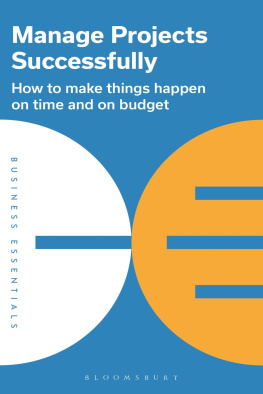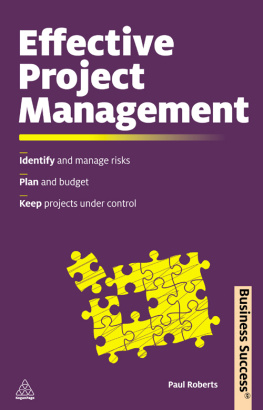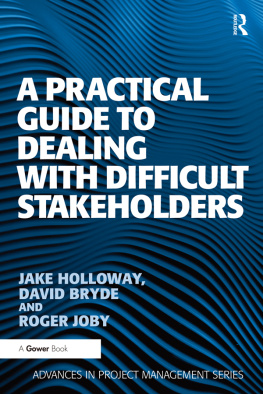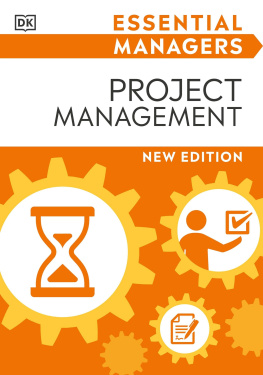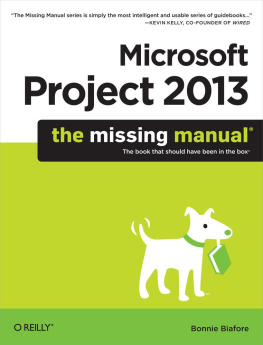


Contents
Answer the questions and work out your score. Then read the guidance points to find out how you can improve your project-management skills.
What skills does project management require?
a. Being an all-rounder with an ability to see the big picture.
b. Nothing special: a cool head, common sense and good organization will see you through!
c. A general understanding of the process and good management skills.
What does the word project mean for you?
a. A finite task with a set cost and timescale.
b. Something thats difficult to accomplish.
c. Its just another word for ordinary work.
Do you feel you use your time effectively at work?
a. Yes. I am completely in control of my time.
b. I mostly stay on top of my work but occasionally run into problems.
c. No. I am completely snowed under.
Do you prioritize your work?
a. Yes. I make sure that I spend my time on important activities.
b. I try to but sometimes find my to-do list over-full.
c. Not really. I just do what grabs my attention.
Are you able to delegate?
a. Yes. I use my team effectively as I cannot be everywhere at once.
b. I do delegate but I find it hard.
c. No. Id rather do things myself.
How do you rate your team management?
a. Good. I run a tight ship.
b. Not bad. Theres room for improvement.
c. Help! My team is a nightmare I cant control them!
Planning is:
a. One of my best skills.
b. A necessary activity, which I find difficult.
c. A waste of time.
Something unexpected happens. How do you react?
a. I keep calm as Ive thought in advance about potential problems.
b. Im normally surprised, but Ill deal with it.
c. I tend to panic.
a = 1, b = 2, c = 3. Now add up your scores.
will be useful for everyone, as it summarizes the essentials of project management. Then, depending on your total score, the most relevant chapters are indicated below.
813: Well done; you have great project-management skills. Theres always something you can learn, though, so look at offers useful tools, such as Gantt charts, which will help with organization.
1419: Youre getting there, but could do with polishing up your skills. will help you cope better in emergencies.
2024: You need some help with your management skills, but dont worry! to fine-tune your planning.
Understanding the basics of project management
Project management is a term thats often bandied about today. It first became popular in the early 1960s, driven by businesses that realized that there were benefits to be gained from organizing work into separate, definable units and from co-ordinating different kinds of skills across departments and professions. One of the first major uses of project management was to handle the US space programme, and governments, military organizations and the corporate world have all since adopted the discipline. In this book, well be looking at how project management works and how you can take the stress out of it, whatever the size of the task at hand.
Although the term is now universally familiar, not that many people fully understand exactly what project management involves. We tend to think of it as common sense, and that anyone can manage anything by being calm and well-organized. These are qualities that a project manager definitely needs, but other things are essential too. Project management is, in fact, a structured way of working and recording events that can bring order and coherence to any set of tasks with a predetermined goal. This chapter sketches the outlines of that structure.
Step one: Define what a project is
Project is one of those terms that is defined in various different ways by different bodies. However, all sources seem to agree that a project is:
a task or set of tasks undertaken within specific timescales and cost constraints in order to achieve a particular benefit
The three stages
Think about the following:
arranging a holiday;
decorating a room;
assembling a garden shed;
moving house;
organizing a party.
These are all examples of a project because they all have three things in common. In each case, you:
Identify a need or benefit first of all.
Start to produce whatever will satisfy the need.
Use, operate or simply enjoy the fruits of your labours once all the work has been done.
This basic three-stage cycle is common to all projects, large and small, whether youre producing a physical product (such as a bridge or computer system), an event (like a product launch or sporting event) or a change in circumstances (an office move or reorganization, for instance).
The three parameters
In addition to the three stages, all projects have three key parameters (or factors) that have to be taken into account:
time
cost
quality (also referred to as performance or specification)
The relationship between these three elements is often shown as a triangle.

This is because, throughout the life of a project, the three factors are likely to come into conflict with one another. You will nearly always find that everyone wants high performance within a very short time, at minimum cost! However, if any one of these factors is absolutely essential, the other two will have to give way to a certain extent its impossible to be in all three corners at once, so you have to set priorities for the project, whatever it is.
Say, for example, your project had been to launch a new website for your business. Your priorities would probably have been in the following order:
time youd have needed to get the new content and design ready for the launch as well as promotions and teasers to announce the new site;
quality it would have been essential that everything was tested and worked properly when the website went live;
cost you might have had to spend whatever was necessary to make sure the other two parameters were met.
When youre beginning a new project, its a useful exercise to place it within this triangle to indicate how flexible or not you could be with any of the three parameters.
So, from a combination of the three stages and the three parameters, we can see that a project:
has a finite and defined life span;
aims to produce a measurable benefit or product;
contains a corresponding set of activities designed to achieve that benefit or product;
has a defined amount of resources allocated.
The structure
The final, vital, requirement is that the project also has a proper organizational structure with defined responsibilities, so that everyone involved knows what they are doing and why; how it must be done; and by when.
TOP TIP
One important thing to bear in mind is that projects are finite they will have a definite beginning and end. If these are unclear, and if you and others are working away without a proper goal in sight, its not a project.
Next page
